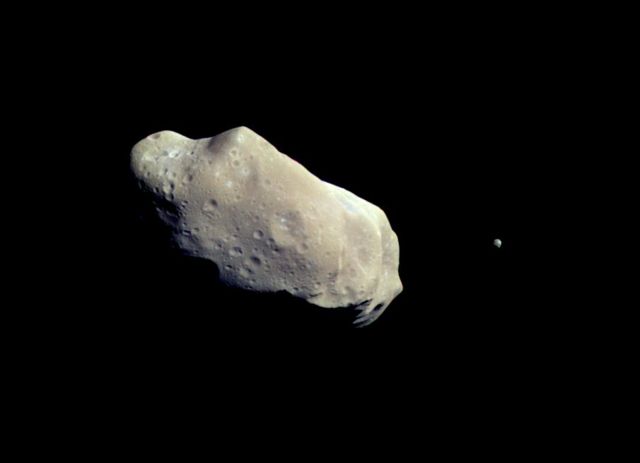From Wikipedia, the free encyclopedia
 Size of this preview: 640 × 463 pixels
Size of this preview: 640 × 463 pixels Full resolution (905 × 655 pixels, file size: 20 KB, MIME type: image/jpeg)
 |
This is a file from the Wikimedia Commons. The description on its description page there is shown below.Commons is a freely licensed media file repository. You can help.
|
Summary
| Description |
This color picture is made from images taken by the imaging system on the Galileo spacecraft about 14 minutes before its closest approach to asteroid 243 Ida on August 28, 1993. The range from the spacecraft was about 10,500 kilometers (6,500 miles). The images used are from the sequence in which Ida's moon was originally discovered; the moon is visible to the right of the asteroid. This picture is made from images through the 4100-angstrom (violet), 7560 A (infrared) and 9680 A (infrared) filters. The color is 'enhanced' in the sense that the CCD camera is sensitive to near infrared wavelengths of light beyond human vision; a 'natural' color picture of this asteroid would appear mostly gray. Shadings in the image indicate changes in illumination angle on the many steep slopes of this irregular body as well as subtle color variations due to differences in the physical state and composition of the soil (regolith). There are brighter areas, appearing bluish in the picture, around craters on the upper left end of Ida, around the small bright crater near the center of the asteroid, and near the upper right-hand edge (the limb). This is a combination of more reflected blue light and greater absorption of near infrared light, suggesting a difference in the abundance or composition of iron-bearing minerals in these areas. Ida's moon also has a deeper near-infrared absorption and a different colour in the violet than any area on this side of Ida. The moon is not identical in spectral properties to any area of Ida in view here, though its overall similarity in reflectance and general spectral type suggests that it is made of the same rock types basically. These data, combined with study of further imaging data and more detailed spectra from the Near Infrared Mapping Spectrometer, may allow scientists to determine whether the larger parent body of which Ida, its moon, and some other asteroids are fragments was a heated, differentiated object or made of relatively unaltered primitive chondritic material. Česky: Planetka (243) Ida se svým měsíčkem Dactylem
Deutsch: 1993: Asteroid Ida mit Mond Dactyl
Magyar: A Galileo űrszonda fényképe a 243 Idáról. Jobbra halványan látszik a Dactyl.
日本語: ガリレオ探査機が撮影したイダと衛星ダクティル(右の点)
|
| Source |
NASA planetary photojournal
|
| Date |
1993-09-28 |
| Author |
NASA/JPL |
Permission
( Reusing this image) |
|
|
This file is in the public domain because it was created by NASA. NASA copyright policy states that "NASA material is not protected by copyright unless noted". ( NASA copyright policy page or JPL Image Use Policy).
Deutsch | English | Español | Français | Galego | Nederlands | Português | Русский | 中文(简体) | 中文(繁體) | +/- |
|
|
|
Warnings:
- Use of NASA logos, insignia and emblems are restricted per US law 14 CFR 1221.
- The NASA website hosts a large number of images from the Soviet/ Russian space agency, and other non-American space agencies. These are not necessarily in the public domain.
- Materials from the Hubble Space Telescope may be copyrighted if they do not explicitly come from the STScI.
- All materials created by the SOHO probe are copyrighted and require permission for commercial non-educational use.
- Images featured on the Astronomy Picture of the Day (APOD) web site may be copyrighted.
|
|
File history
Click on a date/time to view the file as it appeared at that time.
|
|
Date/Time |
Dimensions |
User |
Comment |
| current |
10:44, 30 January 2006 |
905×655 (20 KB) |
Arnomane |
|
|
|
19:52, 1 February 2005 |
679×491 (12 KB) |
Svdmolen |
|
File links
The following file is a duplicate of this file:
The following pages on Schools Wikipedia link to this image (list may be incomplete):


